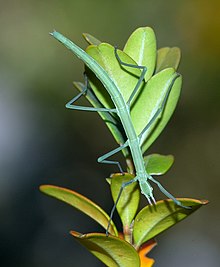
Back شبحيات (حشرات) Arabic شبحيات ARZ Phasmatodea AST Göstərmələr AZ Палачнікі BE Пръчици Bulgarian Fasm BR Fasmatodeus Catalan Phasmida CEB Strašilky Czech
| Phasmatodea Temporal range:
| |
|---|---|

| |
| Pijnackeria hispanica | |
| Scientific classification | |
| Domain: | Eukaryota |
| Kingdom: | Animalia |
| Phylum: | Arthropoda |
| Class: | Insecta |
| (unranked): | Dicondylia |
| Subclass: | Pterygota |
| Infraclass: | Neoptera |
| Cohort: | Polyneoptera |
| Order: | Phasmatodea Jacobson & Bianchi, 1902 |
| Subgroups | |
|
†Susumanioidea | |

The Phasmatodea (also known as Phasmida or Phasmatoptera) are an order of insects whose members are variously known as stick insects, stick bugs, walkingsticks, stick animals, or bug sticks. They are also occasionally referred to as Devil's darning needles, although this name is shared by both dragonflies and crane flies.[1] They can be generally referred to as phasmatodeans, phasmids, or ghost insects, with phasmids in the family Phylliidae called leaf insects, leaf-bugs, walking leaves, or bug leaves. The group's name is derived from the Ancient Greek φάσμα phasma, meaning an apparition or phantom, referring to their resemblance to vegetation while in fact being animals. Their natural camouflage makes them difficult for predators to detect; still, many species have one of several secondary lines of defense in the form of startle displays, spines or toxic secretions. Stick insects from the genera Phryganistria, Ctenomorpha, and Phobaeticus include the world's longest insects.
Members of the order are found on all continents except Antarctica, but they are most abundant in the tropics and subtropics. They are herbivorous, with many species living unobtrusively in the tree canopy. They have an incomplete metamorphosis life cycle with three stages: egg, nymph and adult. Many phasmids are parthenogenic, and do not require fertilized eggs for female offspring to be produced. In hotter climates, they may breed all year round; in more temperate regions, the females lay eggs in the autumn before dying, and the new generation hatches in the spring. Some species have wings and can disperse by flying, while others are more restricted.
- ^ Randolph, Vance (2012). Ozark Magic and Folklore. Dover Publications. ISBN 978-1-306-33958-2. OCLC 868269974.